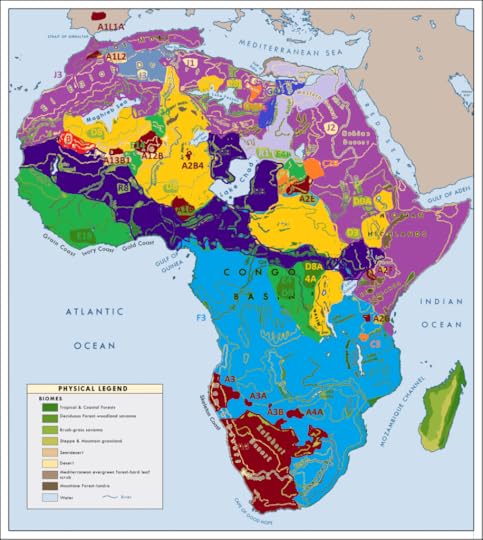Speech of the Sahara Sea

Language families in modern-day Africa
Remember the Peoples of the Sahara Seas? Well, the original creator of the Sahara Seas map, Sean McNight, liked it! That’s all the encouragement I need to go further. The last post took us from the birth of mitochondrial Adam to the non-drying of the Sahara 7,000 years ago. Now I’m going from there to 5,000 years ago and the dawn of history.
A=”Khoisan” group: many language families scattered from Tabernas desert to the tip of Southern Africa. Allied by few linguistic features (click phonemes, vowels distinguished by tone and quality, analytic morphology, and inflectional morphemes) “Khoisan” people are generally grouped together because of shared genetic markers (e.g. Y-chromosome Haplogroup A) and physiology (e.g. “peppercorn” hair, common lack of alveolar ridge). Representative languages: Khoi, San (in southern Africa), !Ku’ten (of the Mara Mountains), and Pàq (of the El Djof Desert).
B=Centimanic family: Confined to a single mountain range in the central western Sahara, the people called “Hectatoncheires” in Greek texts speak a variety of languages within a single family, whose broader affiliations are unknown. The same is true for the Hectatoncheires themselves, equally genetically distant from the Khoisan and every other human group. Language features include “teakettle” phonemes (uvular whistling and overtones). Representative languages: R˦e˨#hs (a.k.a Cannimar [1]).
C= “Pygmy” group: Technically, these are 4 language families with similar features such as click phonemes (including medial clicks), and distinguishing consonants with aspiration, voice, prenasalization, and ejection. Representative languages: Ndzenha (near Lake Malawi) and Ahaolh (a.k.a “Aawokh” in the Libyan Desert).
D=Amo[2]-Saharan family: Or possibly Amo-Saharan plus 2 or 3 other language families. These languages are united by a singular-collective-plurative number system, SOV sentence structure, 3 tones (high, low, and falling), and lentition. Representative languages: Ancient Nubian and modern Nobiin (on the Amim River), Jiar (on Lake Maghreb) and Kebian (on Lake Chad).
E=Neghren-Bindo family: Or possibly 2 language families, or possibly making up a single family with Bantu. Neghren-Bindo languages share CVCV syllable structure, verbs of a root followed by suffixes, nouns of a root preceded by classification prefixes, vowel harmony, nasal/non-nasal vowel contrast, tone, and SVO word order. Representative languages: Shileghery[3] (on the west coast) and Kibi’ndo[4] (in the Bindo basin).
F=Bantu family: Probably related to Neghren-Bindo, with noun classes, verb prefixes, CVCV syllables, and reduplication. Expanded into southern Africa in late pre-history. Representative languages: Gdunyu (in the Gulf of Guinea), Swahili (on the southwest coast), and Dumé (in southern Africa).
G=Gulf family: Possibly related to Indo-European or Kartvelian, but probably not “Scythian” as early scholars suggested. Features long consonant clusters, animate/inanimate gender, noun declension, ditransitive verbs, and inclusive/exclusive pronouns. Representative languages: Ghznuldze (northern) and Kpachhi (southern).
I=Cyclopic family: Genetic evidence indicates a stone-age migration from Europe. Affiliation has been proposed with Basque and Etruscan, as well as paleo-Baltic and Caucasian languages. Features agglutinative nouns, ergative–absolutive alignment. Representative languages: Lanthsminth (on the Occidental River) and Tsodyinyu (on the Choti Sea)
J=Afro-Asiatic family: Many waves of Afro-Asiatic-speaking peoples have migrated into Africa.Their languages feature laryngeal and emphatic consonants, VSO typology, two genders (feminine marked with -t), causative -s- affix, and words inflected by changes within the root. Representative languages: Ancient Idoptian[5] and modern Djemutic [6] (along the Amim), Ancient Phoenician and modern Gnanic (on the Atlas Peninsula)[7], Taram (in northwest Africa)[8], Amhuric (in Ethiopia)[9], and Arabic.
R=Indo-European family (Tsshian sub-family): Idoptian and Akkadian records indicate an invasion by chariot-riding nomads in the 2,500s BCE. The Tsshians [10] ruled Lower Idopt until Ptolemaic times, and begat many modern languages including: Kambdan[11] (on the Amim Delta), Taynadzzian (on the Gulf of Sidra), and Watrandzzade (on Lake Tsad).
R8=Tsadeic family: Not Indo-European as first claimed by European scholars, who noted the similarity of ancient Tsadean gods to the Greek and Hindu pantheons (e.g. Udzus, the sun-god and ruler of the pantheon). These similarities have since been found to be either spurious or the result of contact with the Tsshians and the Greeks. Tsadeic languages are in fact equally distant from Indo-European, Afro-Asiatic, and Amo-Saharan. Efforts have been made to unite them with Gulf languages, Cyclopic, and the Dravidian languages of southern India. Features include with masculine and feminine genders, consonant clusters, SOV typology, tone, desiderative verbs, heavy suffixing, and lack of prefixing. Representative languages: Stlhfwhamar (on the west coast), Qskts’atekh (west of Lake Tsad), Pkshwhade[12] (east of Lake Tsad), and Ks’hsktslhshor (south of the Ethiopian Highlands).
[1] from Saharan kandi “hand” and baru “man.” Now considered offensive.
[2] from the Amim River, OTL’s *Nile
[3] shi-leghery or “the language of Leghery,” the Shileghery pronunciation of the west-Taram name for the Neghren Rivers (the Eastern Negher, or “Niger River” and the Western Negher or “Azaouagh River”), from gher “river.”
[4] from ki–bi’ndo or “language of the hunt(er)”
[5] from Idopt, *Egypt
[6] from Djemut, the “Black Land”
[7] from kaan, the “low” people
[8] sometimes called “Berber.” From ʔm, “strong”
[9] from ʔm wr, the “people of strength”
[10] from tsusis, “army, people” and sius “sun, god”
[11] from karim-an-ka-an-Ptaa, “the temple of the ka of Ptah”
[12] from p-ks-h-wh-ade “the people of the holy, sweet lake of Tsade”




